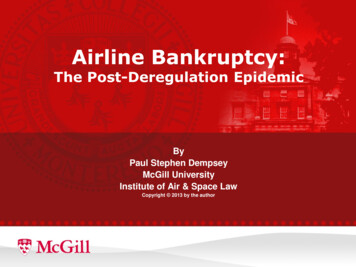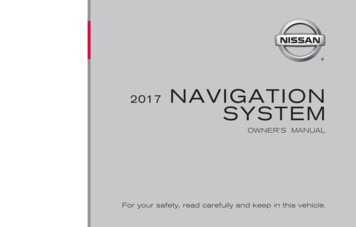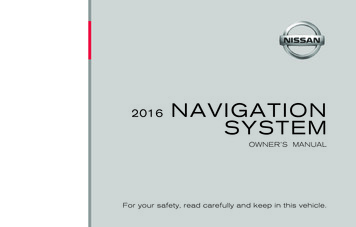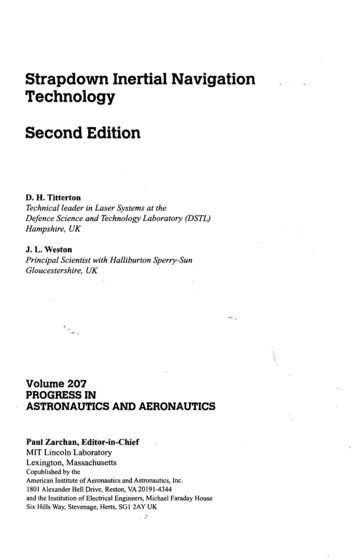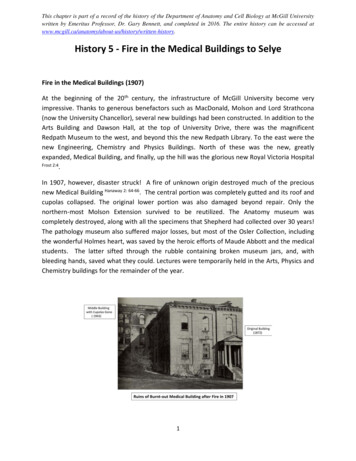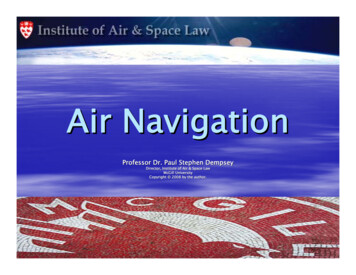
Transcription
Air NavigationProfessor Dr. Paul Stephen DempseyDirector, Institute of Air & Space LawMcGill UniversityCopyright 2008 by the author.
The Importance of Air NavigationAir navigation services are manifestly important to the safety and efficiency ofair transportation. Safety and security of flight depend upon the proficiency ofair navigation. They also impact airline economics both in terms of thecharges they impose upon users of the system, and the delay and circuitythey can impose on aircraft operations.“Among the traditional functions of government, air traffic control is providedfor the purpose of preventing collisions between aircraft in the air andbetween aircraft and obstructions on the ground, as well as expediting andmaintaining an orderly flow of air traffic. In addition to ATC, the effectivemanagement of air traffic requires associated services such as meterology,search and rescue, and telecommunications, as well as the provision ofaeronautical information such as charts.”Ira Lewis
The primary objective of air trafficservices is to prevent collisionsbetween aircraft, and to avoidunnecessary flight delays. Annex 11requires States to provide flightinformation centers and air trafficcontrol units. They provideclearances and information toachieve longitudinal, vertical orlateral separation between aircraft.The world’s airspace is divided intocontiguous flight information regions[FIRs] within which air traffic servicesare provided. An aircraft in flightfollows en route air traffic controlinstructions as it flies throughsuccessive FIRs. Upon approachingan airport at which a landing is to bemade, the aircraft passes into theterminal control area [TCA].
UK Airspace is divided into 2 main areas, known as Flight InformationRegions, or FIRs. The Scottish FIR, and the London FIR. Theresponsibility for these lies with three centres. The London Area andTerminal Control Centre (LATCC) situated at West Drayton, The ScottishOceanic and Area Control Centre at Prestwick, and the Manchester AreaControl Centre (MACC), at Manchester Airport.
The Chicago Convention of 1944 Article 1 – Each State has complete and exclusivesovereignty over its airspace; Article 5 – States may prescribe specific routes for nonscheduled flights; Article 6 – Scheduled flights may not be conducted overthe territory of another State without its authorization; Article 8 – No pilotless aircraft may be flown over theterritory of another State without special permission;
Designated RoutesArticle 68 – Each State maydesignate international airroutes and internationalairports in its territory;
PROHIBITED ZONESArticle 9: States may establish “prohibited areas” for military orpublic safety reasons; such prohibited areas must be of reasonable extent andlocation as not to unnecessarily interfere with airnavigation; in exceptional circumstances, or during periods ofemergency or in the interest of public safety, States mayimmediately and temporarily restrict or prohibit flying overthe whole or part of its territory, without discrimination as toaircraft nationality; States may require that aircraft finding themselves in “nofly” zones to promptly land at a designated airport.
Annexes 2, 4 and 15 Prohibited area – an air spaceof defined dimensions above theland area or territorial waters ofa State, within which the flight ofaircraft is prohibited; Restricted area – an air spaceof defined dimensions above theland areas or territorial waters,within which the flight of aircraftis restricted in accordance withcertain specified conditions; and Danger area – a specified areawithin which activitiesdangerous to flight exist atspecified times.
KAL 007 Resulted in Art. 3 bisArticle 3 bis States may requireaircraft flying through itsair space withoutpermission to landpromptly at a designatedairport. However, States mustrefrain from usingweapons against civilaircraft in flight orendangering the lives ofpersons on board or thesafety of aircraft; States retain their right ofself-defense under Article51 of the UN Charter.
Annex 2 Interception is to be undertakenonly as a last resort; If undertaken, interception shallbe limited to determining theidentity of the aircraft, unless it isnecessary to return it to itsplanned track, direct it beyondthe boundaries of national airspace, guide it away fromprohibited, restricted or dangerareas, or instruct it to land at adesignated airport.
Aircraft in Distress andAccident InvestigationArticle 25 – States must provideassistance to aircraft in distress;Article 26 – the State in which anaviation accident involves death orserious injury shall investigate itscauses; the State of aircraftregistry may appoint observers
Annex 13 The State where the accident occurred maydelegate its investigatory responsibilities toanother State. Investigation of accidents outside the territory of aState shall be conducted by the State of Registryof the aircraft. Records shall not be disclosed unless the courtsdetermine that disclosure outweighs the adverseimpacts such action may have on futureinvestigations. The purpose of the investigation is to preventfuture accidents, not to apportion blame or liability.
Facilitation of Air NavigationArticle 22 – States must adopt all practicablemeasures to facilitate and expedite navigation byaircraft and prevent unnecessary delays;Article 28 – States in their territories must provideairports, radio and meteorological services, andother navigational facilities; States mustimplement SARPs addressing communications,codes, marking, signals, and operatingprocedures, and aeronautical maps and charts.
Uniform Conditions andNondiscriminatory ChargesArticle 11 – air navigation rules must be nondiscriminatory;Article 15 – air navigation charges must be nondiscriminatory;
Article 15 uniform conditions shall apply to the use of air navigationfacilities by aircraft of every contracting State; air navigation charges shall not be higher for scheduledforeign aircraft than national aircraft engaged in similarinternational operations; no charge may be imposed solely for the right of transitover, entry into, or exit from its territory; charges imposed shall be published and communicated tothe ICAO Council; and if a contracting State so requests, the ICAO Council mayreview such charges and report and makerecommendations thereon to the concerned State(s).
Airport and ATC ChargesCharges are fees paid by airlines for services and facilitiesprovided by airports and ANSPs such as: Use of the runway (landing charges) Use of the airport infrastructure (parking and boardingbridge charges) Use of the terminal building (passenger charges) Airport security (security charges) Protection of the environment (noise charges) Air traffic control (en route navigation and terminalcharges) Other air navigation services (Meteorological andAeronautical Information Services) Source: IATA
IATA’s Concerns Worldwide, airlines and their passengers pay atleast US 43.5 billion a year to airports and ANSPsor 11% of airline revenues. These infrastructure charges form the 2nd largestexternal cost to airlines after fuel. Over the past 5 years airport aeronauticalrevenues per passenger increased 27%. The unit cost of air navigation increased 9.4%during the same period. At the same time airlines reduced unit costs(excluding fuel) by 16%. Source: IATA
States Must Ensure Compliance Article 12 – States must assure that aircraft in its territory orcarrying its nationality shall “comply with the rules andregulations relating to the flight and maneuver there in force”;such domestic regulations shall be uniform, to the greatestpossible extent, with SARPs; rules over the high seas shall bethose established by ICAO;
Duties of StatesArticle 37 – States must “collaborate in securing the highestpracticable degree of uniformity in its regulations, standards,procedures, and organization” so as to “facilitate and improveair navigation.” ICAO shall adopt SARPs addressingcommunications systems, characteristics of airports andlanding areas, collection and exchange of meteorologicalinformation, aeronautical maps and charts, aircraft in distressand accident investigation, “and such other matters concernedwith the safety, regularity, and efficiency of air navigation asmay from time to time appear appropriate”;Article 38 - States that find it “impracticable to comply” withSARPs shall notify ICAO immediately; ICAO shall immediatelynotify all other States of the differences between the SARPsand the national practice of that State.
FORCE MAJEURE Article 89 – in case of war or national emergency, theConvention shall not affect the freedom of action of anyState;
Pursuant to Articles 9and 89 of the ChicagoConvention, the U.S.Federal AviationAdministrationgrounded allcommercial aircraftover U.S. airspace forthree days followingthe September 11,2001 attack.
The Role of ICAOArticle 44 – ICAO shall “develop the principles and techniques ofinternational air navigation”; it shall promote safety of flight, andencourage the development of air navigation facilities;Article 69 – if the ICAO Council concludes a State’s air navigationfacilities are deficient, it may consult with said State;Articles 70, 71 & 74 – the ICAO Council may finance, or provide, airnavigation services, or provide technical assistance if deficiencies exist,and the State agrees.
ICAO’s NavigationRelated SARPSAnnex 2 – Rules of the AirAnnex 3 – MeteorologyAnnex 4 – Aeronautical ChartsAnnex 5 – Units of Measurement to BeUsed in Air-Ground CommunicationsAnnex 6 – Operation of Aircraft,International Commercial Air TransportAnnex 10 – AeronauticalCommunicationsAnnex 11 – Air Traffic ServicesAnnex 15 – Aeronautical InformationServices
ANNEX 2 - Rules of the Air Annex 2 consists of general rules, visual flight rules and instrument flight rules. Thepilot-in-command of an aircraft is responsible for compliance with the rules of the air.An aircraft must be flown in accordance with the general rules and either the visualflight rules (VFR) or the instrument flight rules (IFR). Flight in accordance with visualflight rules is permitted if a flight crew is able to remain clear of clouds by a distanceof at least 1 500 m horizontally and at least 300 m (1 000 ft) vertically and to maintaina forward visibility of at least 8 km. For flights in some portions of the airspace and atlow altitudes, and for helicopters, the requirements are less stringent. An aircraftcannot be flown under VFR at night or above 6 100 m (20 000 ft) except by specialpermission.Most airliners fly under IFR at all times. When operating under air traffic control theaircraft must maintain precisely the route and altitude that have been assigned to itand keep air traffic control informed about its position.A flight plan must be filed with air traffic services units for all flights that will crossinternational borders, and for most other flights that are engaged in commercialoperations. The flight plan provides information on the aircraft's identity andequipment, the point and time of departure, the route and altitude to be flown, thedestination and estimated time of arrival, and the alternate airport to be used shouldlanding at destination be impossible. The flight plan must also specify whether theflight will be carried out under visual or instrument flight rules.Regardless of the type of flight plan, the pilots are responsible for avoiding collisionswhen in visual flight conditions, in accordance with the principle of see-and-avoid.However, flights operating under IFR are either kept separated by air traffic controlunits or provided with collision hazard information. Source: ICAO
ANNEX 3 - Meteorological Service forInternational Air Navigation Annex 3 requires the provision of necessary meteorological information to operators,flight crew members, air traffic services units, search and rescue units, airportmanagement and others concerned with aviation.At international aerodromes the meteorological information is normally supplied toaeronautical users by a meteorological office. Aerodrome reports include surfacewind, visibility, runway visual range, present weather, cloud, air and dew-pointtemperature and atmospheric pressure, and are issued either half-hourly or hourly.These reports are complemented by special reports whenever any parameterchanges beyond pre-fixed limits of operational significance. Aerodrome forecastsinclude surface wind, visibility, weather, cloud and temperature, and are issued everythree or six hours for a validity period of 9 to 24 hours.Landing forecasts contain expected conditions over the runway complex in regard tosurface wind, visibility, weather and cloud.To assist pilots with their flight planning, most States provide meteorological briefingswhich are increasingly carried out using automated systems. Briefings comprisedetails of en-route weather, upper winds and upper-air temperatures, often given inthe form of meteorological charts, warnings related to hazardous phenomena enroute, and reports and forecasts for the destination aerodrome and its alternates.To provide aircraft in flight with information about significant changes in weather,meteorological watch offices are maintained. They prepare warnings of hazardousweather conditions. Furthermore, aircraft in flight are required to report severeweather phenomena encountered en route. These reports are disseminated by theair traffic services units to all aircraft concerned.ICAO has implemented the World Area Forecast System (WAFS) to provide Statesand aviation users with standardized and high-quality forecasts on upper-airtemperature, humidity and winds and on significant weather. Source: ICAO
ANNEX 4 - Aeronautical Charts Annex 4 defines the obligations of States to make available certain ICAOaeronautical chart types, and specify chart coverage, format, identification andcontent including standardized symbology and colour use. The goal is to satisfythe need for uniformity and consistency in the provision of aeronautical chartsthat contain appropriate information of a defined quality. The ICAO series ofaeronautical charts now consists of twenty-one types, each intended to servespecialized purposes. They range from detailed charts for individualaerodromes/heliports, to small-scale charts for flight planning purposes, andinclude electronic aeronautical charts for cockpit display.There are three series of charts available for planning and visual navigation,each with a different scale. The Aeronautical Navigation Chart — ICAO SmallScale charts cover the largest area for a given amount of paper; they provide ageneral purpose chart series suitable for long-range flight planning. The WorldAeronautical Chart — ICAO 1 : 1 000 000 charts provide complete worldcoverage with uniform presentation of data at a constant scale, and are used inthe production of other charts. The Aeronautical Chart — ICAO 1:500 000series supplies more detail and provides a suitable medium for pilot andnavigation training. This series is most suitable for use by low-speed, short- ormedium-range aircraft operating at low and intermediate altitudes.The vast majority of scheduled flights take place along routes defined by radioand electronic navigation systems that make visual reference to the groundunnecessary. This type of navigation is conducted under instrument flight rules.Source: ICAO
ANNEX 5 - Units of Measurement to beUsed in Air and Ground Operations At the International Civil Aviation Conference held at Chicago in 1944, theimportance of a common system of measurements was realized and aresolution was adopted calling on States to make use of the metric system asthe primary international standard.Adopted in 1979, Amendment 13 of Annex 5 extended ICAO's role instandardizing units of measurements to cover all aspects of air and groundoperations, and not just air-ground communications. It also introduced theInternational System of Units, known as SI from the "Système Internationald’Unités", as the basic standardized system to be used in civil aviation.In addition to the SI units, the amendment recognized a number of non-SI unitswhich may be used permanently in conjunction with SI units in aviation,including the litre, the degree Celsius, and the degree for measuring planeangle. There are some non-SI units which will have to be retained, at leasttemporarily, including the nautical mile and the knot, as well as the foot when itis used in the measurement of altitude, elevation or height only.Amendments 14 and 15 to Annex 5 introduced a new definition of the metre,and references to temporary non-SI units were deleted. Source: ICAO
ANNEX 6 - Operation of Aircraft Annex 6 covers such areas as aircraft operations, performance, communications andnavigation equipment, maintenance, flight documents, responsibilities of flightpersonnel and the security of the aircraft.SARPs exist in respect of operating minima based on the aircraft and theenvironmental factors found at each aerodrome. Subject to the State of theOperator's approval, the aircraft operator has to take into account the type ofaeroplane or helicopter, the degree of sophistication of equipment carried on theaircraft, the characteristics of the approach and runway aids and the operating skill ofthe crew in carrying out procedures involved in operations in all weather conditions.Annex 6 spells out the responsibilities of States in supervising their operators,particularly in respect of flight crew. It calls for the provision of an operations manualfor each aircraft type, and places the onus on each operator to ensure that alloperations personnel are properly instructed in their duties and responsibilities, and inthe relationship of such duties to the airline operation as a whole.The pilot-in-command has the final responsibility to make sure that flight preparationis complete and conforms to all requirements, and is required to certify flightpreparation forms when satisfied that the aircraft is airworthy, and that other criteriaare met in respect to instruments, maintenance, mass and load distribution (and thesecuring of the loads), and operating limitations of the aircraft. Annex 6 also requiresoperators to establish rules limiting the flight time and flight duty periods for flightcrew members.The Annex also sets out minimum performance operating limitations with respect toaircraft taking into account the mass of the aircraft, elevation, temperature, weatherconditions and runway conditions, and include take-off and landing speeds underconditions which involve the failure of one or more power-units.Part II of Annex 6 deals with aeroplanes in international general aviation.International commercial in transport operations and general aviation operations inhelicopters is covered in Part III. Source: ICAO
ANNEX 10 - Aeronautical Telecommunications Annex 10 is divided into five volumes:Volume I — Radio Navigation Aids is a technical document which defines forinternational aircraft operations the systems necessary to provide radio navigation aidsused by aircraft in all phases of flight. The SARPs and guidance material of this volumelist essential parameter specifications for radio navigation aids such as the globalnavigation satellite system (GNSS), instrument landing system (ILS), microwavelanding system (MLS), very high frequency (VHF) omnidirectional radio range (VOR),non-directional radio beacon (NDB) and distance measuring equipment (DME).In Volume II — Communications Procedures including those with PANS status,general, administrative and operational procedures pertaining to aeronautical fixed andmobile communications are presented.Volume III — Communication Systems contains SARPs and guidance material forvarious air-ground and ground-ground voice and data communication systems,including aeronautical telecommunication network (ATN), aeronautical mobile-satelliteservice (AMSS), secondary surveillance radar (SSR) Mode S air-ground data link, veryhigh frequency (VHF) air-ground digital link (VDL), aeronautical fixedtelecommunication network (AFTN), aircraft addressing system, high frequency datalink (HFDL), aeronautical mobile service, selective calling system (SELCAL),aeronautical speech circuits and emergency locator transmitter (ELT).Volume IV — Surveillance Radar and Collision Avoidance Systems contains SARPsand guidance material for secondary surveillance radar (SSR) and airborne collisionavoidance systems (ACAS), including SARPs for SSR Mode A, Mode C and Mode S,and the technical characteristics of ACAS.In Volume V — Aeronautical Radio Frequency Spectrum Utilization, SARPs andguidance material on the utilization of aeronautical frequencies are defined. Volume Vcontains information on the assignment planning of individual aeronautical radiostations operating or planned to operate in different frequency bands. Source: ICAO
ANNEX 11 - Air Traffic Services Addresses ways of preventing collision between aircraft, expediting andmaintaining an orderly flow of air traffic, providing advice and information for thesafe and efficient conduct of flights, and alerting service for aircraft in distress.To meet these objectives, ICAO provisions cal l for the establishment of flightinformation centres and air traffic control units.The world's airspace is divided into a series of contiguous flight informationregions (FIRs) within which air traffic services are provided.Air Traffic Control services consists of clearances and information issued byATC units to achieve longitudinal, vertical or lateral separation of aircraft. Allaircraft fly in accordance with either instrument flight rules (IFR) or visual flightrules (VFR).Requires States to implement air traffic services (ATS) safety managementprogrammes to ensure that safety is maintained in the provision of ATS withinairspaces and at aerodromes.Air traffic control service consists of clearances and information issued by airtraffic control units to achieve longitudinal, vertical or lateral separation betweenaircraft.Provides for ATC units to specify restrictions to the traffic flow, when required,for the purpose of avoiding excessive delays to aircraft in flight.Specifies the requirements for coordination between the civil air traffic controlunits and military authorities.Alert the rescue coordination centres when an aircraft is believed or known tobe in distress. Source: ICAO
ANNEX 15 - Aeronautical Information Services Annex 15 defines how an aeronautical information service (AIS) shall receive and/or originate,collate or assemble, edit, format, publish/store and distribute specified aeronauticalinformation/data. The goal is to satisfy the need for uniformity and consistency in the provision ofaeronautical information/data that is required for the operational use by international civil aviation.The philosophy underlying Annex 15, which stems from Article 28 of the Convention onInternational Civil Aviation, is that each State is responsible for making available to civil aviationinterests any and all information which is pertinent to and required for the operation of aircraftengaged in international civil aviation within its territory, as well as in areas outside its territory inwhich the State has air traffic control or other responsibilities.Aeronautical information is handled differently depending on its urgency, operational significance,scope, volume and the length of time it will remain valid and relevant to users. Annex15 specifiesthat aeronautical information be published as an integrated aeronautical information package. It iscomposed of the following elements: the Aeronautical Information Publication (AIP), includingamendment service, AIP supplements, international notices to airmen (NOTAM), pre-flightinformation bulletins (PIB), aeronautical information circulars (AIC), checklists and lists of validNOTAM.The need, role and importance of aeronautical information/data have changed significantly withthe evolution of the Communications, Navigation and Surveillance/Air Traffic Management(CNS/ATM) systems. The implementation of area navigation (RNAV), required navigationperformance (RNP) and airborne computer-based navigation systems has brought about exactingrequirements for the quality (accuracy, resolution and integrity) of aeronautical information/dataand terrain data.States must establish a quality system and put in place quality management procedures at allstages (receiving and/or originating, collating or assembling, editing, formatting, publishing, storingand distributing) of the aeronautical information/data process. The quality system must bedocumented and demonstrable for each function stage, ensuring that the organizational structure,procedures, processes and resources are in place in order to detect and remedy anyinformation/data anomalies during the phases of production, maintenance and operational use.Explicit in such a quality management regime is the ability to trace all information/data from anypoint, back through the proceeding processes, to its origin. Source: ICAO
Additionally, best practices for air navigationhave been identified in various Proceduresfor Air Navigation Services [PANS].PANS are operating practices too detailed for SARPs; they amplify the basic principlescontained in the corresponding SARPs
Air Traffic ManagementAir traffic management [ATM] is a system consisting of aground part and an air part.The airborne part of ATM consists of the functionalcapability which interacts with the ground part to attainthe general objectives of ATM.The ground part of ATM comprises the functions of AirTraffic Services [ATS], Airspace Management [ASM]and Air Traffic Flow Management [ATFM].Air Traffic Services is a generic term meaning variously,flight information services, alerting service, air trafficadvisory service, and Air Traffic Control service (areacontrol service, approach control service or aerodromecontrol service).[1][1] Roderick van Damm,Damm, A European Legal Framework for Air Traffic Management (presentation(presentation before the McGill University Institute of Air & Space Law, Montreal,Canada, Jan. 11, 2006).
AIR TRAFFIC CONTROLAir traffic control [ATC] is typicallydivided into three areas:1. Area control is designed to ensureadequate separation of aircraftonce an aircraft has left theairspace controlled by an airportand is en route to another airport.2. Approach control (or terminal radarcontrol) gives approaching anddeparting aircraft radio instructionswithin the approach control area(the airspace extending like astaircase from the airport. Airportsurveillance radar monitorslocation and altitude of aircraftunder terminal radar control.3. Aerodrome control consists ofclearance given to an aircraftlanding at or taking off from anairport in a control zone. This isperformed from the air trafficcontrol tower located at the airport.
ICAO is attempting to assist States in GNSSsatellite-based communications, navigationand surveillance/air traffic management(CNS/ATM) systems.
Air NavigationServiceProvidersThere are three forms ofclassical” ANS providers: Individual State Joint States (e.g.EUROCONTROL MUAC andEAD) Non-Governmental Entity onbehalf of a State/States
ANSP OrganizationalStructuresANS OrganizationsDegree ofCommercialization0%State Authority (CAA)Autonomous State EntityState-owned Corporation (Crown corporation)Concession/Lease (all or part of the facilities)Partial Privatization (e.g. non-aeronautical)Not-for-profit (stakeholder owned) CorporationFully Privatized Company (publicly traded shares)100%
Problems of TraditionalGovernmental Institutions Governmental institutions have had difficultyin keeping pace with the capital needs of ANSto accommodate rapidly growing trafficdemands and maintain high levels of safety inaviation; Governmental institutions usually arerestricted in their ability to borrow money incapital markets to finance infrastructureimprovements. Governmental institutions are subject togovernmental procurement and decisionalpolicies and practices, imposing bureaucraticefficiency impediments; and Governmental institutions are subject to civilservice labor costs and staffing levelsundisciplined by market forces.
Advantages of NGOs Typically, they are financially self-sufficient, weaned fromgovernment subsidies; They are better able to raise capital in the market, andthereby meet growing capacity needs; They are more efficient, and more capable of reducingcosts for users, and subsidy requirements fromgovernments; They can have governance structures allowing usersgreater access and input on decisionmaking;and They usually move to a more equitable user-chargeapproach to cost allocation.
IATA’s Concerns About CorporatizationANS commercialization may have a negative side, inparticular when the principal objective is to maximize profits.No matter what organizational form an airport or ANS entityassumes through the process of commercialization, itremains by its nature a monopoly on which the users arecompletely dependent. There are a growing number ofcases of abuse of this monopolistic situation by newlycreated commercial organizations, often with the complicityof the governments concerned.IATA’s experience is that, in many cases,commercialization has resulted in significant increases in theairport and ANS cost base that are used to determinecharges. In addition, the promised increases in efficiencyand productivity have not always materialized.
ICAO RecommendationsICAO recommended several of the followingrequirements for the ANS provider:(1)the organization should be subject to the Stateobligations under the Chicago Convention;(2)its Charter should provide for appointment of aBoard of Directors;(3)the organization should be self-financing, obtainfunds from commercial mark
Air navigation services are manifestly important to the safety and efficiency of air transportation. Safety and security of flight depend upon the proficiency of air navigation. They also impact airline economics both in terms of the charges they impose upon users of the system, and the delay and circuity they can impose on aircraft operations.




